Safe storage
Gonzalez, who founded Pacific Harvest Seafood in 2002, says that vacuum packaging can double the long-term storage of frozen fish.
He also advises: “Fresh seafood should be held in temperatures just above freezing to extend shelf life, whereas frozen fish should be held in the coldest possible temperatures, especially fish with high oil content like salmon and black cod that tend to have oil migration problems in freezers higher than -18°C. Oil migration can develop rancidity in ‘warmer’ freezers and cause freezer burn.”
Pugnet describes the shelf-life of fresh seafood as “a constant reminder” to chefs that they need to cook those products promptly, before they expie.
Pugnet adds:“Storing fresh seafood products in the desert is a very interesting challenge from a logistics perspective. Everything starts with the conditioning in Brittany [in France], to make sure our products handle the shipping, by road first, then by plane in the best conditions.
“The cold chain (0 to +4°C is maintained during every step of the journey to the UAE. And in an ideal world, shellfish and crustaceans are placed in aquariums and pools with seawater from their country of origin before delivery to the clients.”
Asked about the optimal way to store seafood, Reilly, tells Caterer Middle East: “Storage varies depending on the type of seafood; most seafood need temperatures just above freezing to keep the freshness as long as possible.
“Most fish hate being frozen, upon defrosting, most of the water content and flavour is lost resulting in a dry firm texture once cooked.”
Touching on wastage concerns, he continues: “The main concern is keeping the fish fresh, most will only last a matter of days so correct planning and ordering is essential especially with imported seafood. “Shellfish are tricky, most of the weight of lobsters for example is the shell and paying per kilogram results in a lot of money in the garbage.
This is why most shells are used to make sauces and soups to gain some extra revenue with unused parts of the shellfish.”

| Advertisement |










 Search our database of more than 2,700 industry companies
Search our database of more than 2,700 industry companies









